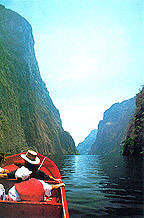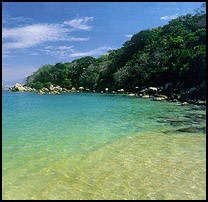 GEOGRAPHY, CLIMATE AND ENVIRONMENT GEOGRAPHY, CLIMATE AND ENVIRONMENT |
Covering almost 2 millions sq km, Mexico is almost 3500 Km as the crow flies from Tijuana, in the Northwest, to Cancun in the Southeast, or about 4600 Km by road. It is the 13th largest country in the world and its population of approximately 93 million is unevenly distributed throughout its territory.

Mexico curves from Northwest to Southeast, narrowing to the Isthmus of Tehuantepec in the South and then continuing northeast to the Yucatán peninsula.
Mexico has a 3326 Km northern border with the US, the eastern half of which is formed by the Rio Bravo del Norte (Rio Grande). In the South and Southeast are a 962 Km border with Guatemala and a 250 km border with Belize.
Northern and Central Mexico have coastal plains on the East and West and two north-south mountain ranges framing a group of broad central plateaus known as the Altiplano Central. It is divided into northern and central parts, themselves split by minors ranges and varies in altitudes (from more or less 1000 meters in the north to 2000 meters in the centre). The northern plateau extends northward into Texas
Northern Mexico is dominated by 2 deserts: the Desierto Sonorense, west of the Sierra Madre Occidental, and the Desierto Chihuahuaense, occupying much of the Altiplano Central.
 CLIMATE CLIMATE |
The tropic of Cancer cuts across Mexico north of
Mazatlán and Tampico. South of the tropic
is hot and humid along the coastal plains on either
side of the country. Inland, at higher elevations,
such as at Guadalajara or Mexico city, the climate
is much more dry and temperate, and the mountain
peaks are often capped with snow. |
The hot wet season is May to October, with the hottest and wettest months falling between June and September for most of the country. Low-lying coastal areas are wetter and hotter than elevated inland ones, even though there is considerable local variation.
North Western Mexico and inland northern areas are drier than the rest of the country. North winds can make inland northern Mexico decidedly chilly in winter, with temperatures sometimes approaching freezing.
 ENVIRONMENT ENVIRONMENT |

Bridging temperate and tropical regions, Mexico has an enormous range of natural environments. Its rugged, mountainous topography adds to the variety by creating countless microclimates, which support one of the most diverse arrays of plant and animal species of any country on the planet. With 1041 bird species, 439 mammals, 989 amphibians and reptiles and about 2600 plants, Mexico is one of the planet's most biologically diverse nations. Mexico is one of the worlds five richest countries in terms of biological diversity. Apart from Brazil, Colombia and Thailand, Mexico has the most varied plants and wildlife in the world. Home to the one of the worlds largest groups of reptiles and the number two position of mammals and amphibians. This country is a showcase of eco systems, ranging from deserts in the north, pine forests in the middle and vast and elaborate tropical jungles in the south.
Whether your interest is in bird Watching or White- water rafting, Mexico is an incredible centre for ecological and adventure tourism. It offers an opportunity to witness and experience such unforgettable sights as a forest carpeted by millions of monarch butterflies, a close encounter with curious and friendly Gray whales, or a family of spider monkeys taking turns swinging from tree tops overhead. |

